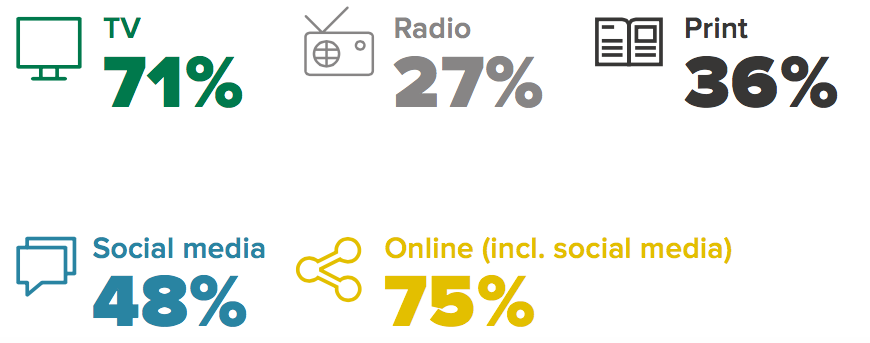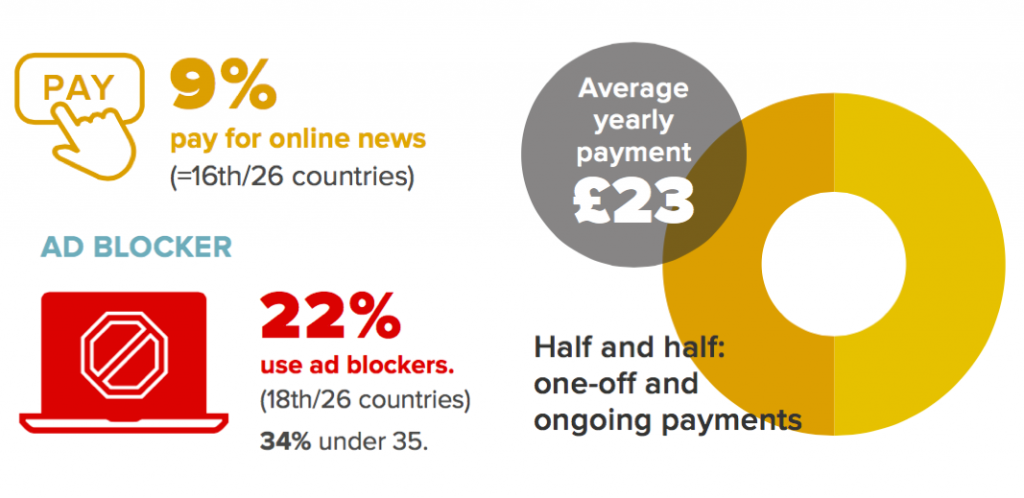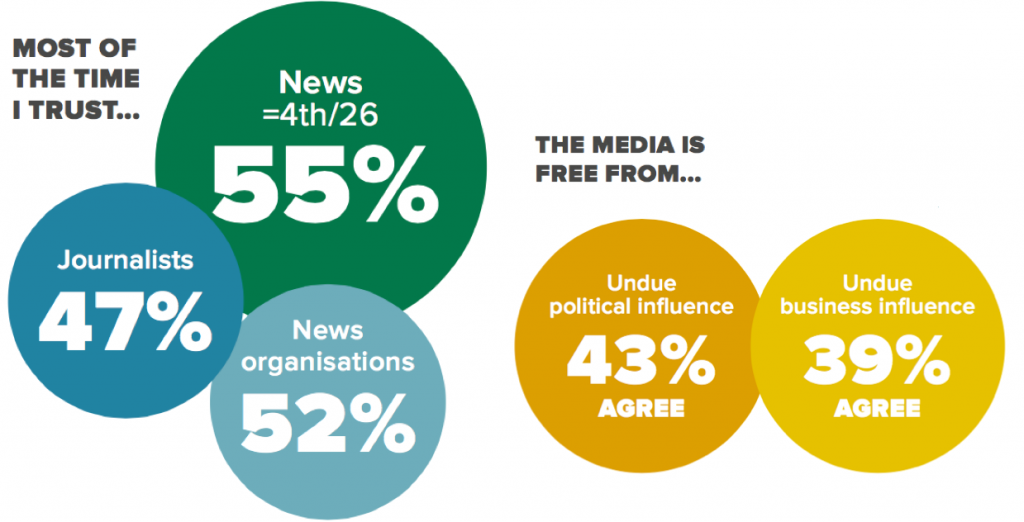| Statistics | |
| Population | 35.5m |
| Internet penetration | 93% |
In this highly concentrated and bilingual media environment, 1 traditional media brands, especially television, remain dominant; major newspapers are experimenting with free tablet apps or paywalls; and the public broadcaster remains a strong presence across platforms.
Top Brands % Weekly Usage (TV, Radio and Print: English Speaking)
| Weekly use | Main source | |
|---|---|---|
| CTV news | 35% | 14% |
| Global news | 32% | 12% |
| CBC news | 29% | 12% |
| Local radio news | 23% | 8% |
| CNN | 22% | 5% |
| CityTV News | 20% | 6% |
| Local daily newspaper | 15% | 4% |
| Toronto Star | 13% | 5% |
Top Brands % Weekly Usage (Online: English Speaking)
| Weekly use | Main source | |
|---|---|---|
| CBC News online | 28% | 10% |
| CTV News online | 25% | 8% |
| Yahoo News | 22% | 9% |
| Huffington Post | 21% | 4% |
| Global News online | 18% | 5% |
| MSN News | 18% | 6% |
| CNN online | 18% | 4% |
| BuzzFeed News | 15% | 3% |
Top Brands % Weekly Usage (TV, Radio and Print: French Speaking)
| Weekly use | Main source | |
|---|---|---|
| TVA/LCN news | 64% | 41% |
| Radio-Canada/RDI news | 46% | 20% |
| Journal de Montréal/de Québec | 31% | 8% |
| Local or regional weekly | 18% | 3% |
| Local radio news | 14% | 4% |
| La Presse | 11% | 2% |
| 24 hours | 9% | 1% |
| Métro | 9% | 1% |
Top Brands % Weekly Usage (Online: French Speaking)
| Weekly use | Main source | |
|---|---|---|
| TVA News online | 39% | 19% |
| La Presse online | 24% | 12% |
| Radio-Canada/RDI News online | 24% | 6% |
| Journal de Montréal/de Québec online | 23% | 7% |
| MSN News | 17% | 7% |
| Canoe.com | 15% | 4% |
| Local radio news online | 11% | 2% |
| Huffington Post | 10% | 2% |
Overview of key developments
By Colette Brin
Centre d’études sur les médias, Université Laval
Canadian media companies are faced with changing consumption habits and declining advertising revenues, especially in print media and more modestly in television. Advertising dollars have largely transferred online since 2009, in large part towards social media, search engines, and other web-only media. 2 chain acquired the English-language Sun chain from Québecor and proceeded to merge newsroom operations in cities where it owned more than one newspaper, laying off 90 employees.
In Halifax, the Chronicle-Herald staff were locked out in early 2016. Two newspapers closed: the Nanaimo Daily News (Black Press) and the Guelph Mercury (Torstar). The Mercury’s closure is particularly symbolic, as it was founded in 1867, the same year as the Canadian Confederation.
In terms of digital-born media, the most successful are imports from across the US border. Yahoo! News is the strongest web-only news brand in English Canada while the Huffington Post’s Canadian and Québec editions are well-established. BuzzFeed Canada was launched in June 2015. There are some alternative web-only news sources in Canada, but their reach and production resources are relatively small.
Until recently, French-language media had been somewhat protected due to language-specific media consumption, a less pronounced economic downturn, and a slower digital shift. However, French-speaking Quebecers are now spending more time consuming news online, including mobile technologies, than on television, and the main news providers have laid off staff in the past year.
Québecor’s newspaper holdings (Journal de Montréal/Journal de Québec) abandoned their paywalls in late 2015, making all their content available for free. Both newspapers also joined Facebook’s Instant Articles system, as did magazines Maclean’s and Chatelaine, and the TV network Sportsnet.
Paying for news
Publishers are struggling to persuade Canadians to pay for content with so much available for free – especially via the public broadcasters and free apps offered by daily newspapers.
Trust
Canadians have consistently shown relatively high levels of trust in news sources, particularly when compared to the US. Support for public broadcasting also remains relatively strong despite low ratings (especially in English Canada) and various critiques from different groups (i.e. commercialisation, suspicion of political bias, insufficient regional or minority coverage).
Scroll data area to see more
TOP SOCIAL NETWORKS*
| RANK | NETWORK | ALL | U35s |
|---|---|---|---|
| 1 | 46% | 58% | |
| 2 | YouTube | 17% | 24% |
| 3 | 12% | 19% | |
| 4 | Google+ | 4% | 3% |
| 5 | 3% | 8% |
- As of the 2011 census, English was the first language spoken in the home by 66% of the population and French by 21% (13% spoke another language). Over 90% of
French-speaking Canadians reside in Québec. ↩ - https://web.archive.org/web/20170719162859/http://www.cem.ulaval.ca/pdf/Donneesfinancieres.pdf
There was positive news for Canada’s public service broadcasters, CBC/Société Radio-Canada (SRC), when the newly elected Liberal government increased funding by $675m over five years in September 2015 – reversing cuts implemented by the Conservatives. By contrast, commercial television stations in Canada have seen their revenues decline by 14% between 2012 and 2014. The broadcast regulator, CRTC, has expressed concern over the consequent reduction of resources devoted to local news production (-4% full-time employees). These losses occurred at the same time as the abolition of the Local Programming Improvement Fund in 2014.
In digital, there has been much focus on the pioneering strategy of La Presse, the French-language publisher with the largest readership (including digital platforms). In January it stopped printing a newspaper on weekdays, leaving just its Saturday print edition. Meanwhile the award-winning La Presse+ app, launched in 2013, reports steady increases in readership, with more than 250,000 weekly tablet users.
Canada’s most widely read newspaper, The Toronto Star, adopted the design and technology behind LaPresse+ in September to create its own tablet application. However, despite a sizeable investment ($14m in 2015 and $10m planned for 2016), the Star Touch app (Toronto Star) reached only 26,000 daily users as of March 2016. Both apps offer their full content free of charge, as do the six regional Québec newspapers acquired in 2015 by Groupe Capitales Médias from Gesca, La Presse’s parent company.
Some newspapers, like the Globe and Mail and the Postmedia group, have introduced paywalls or other forms of payment for content. Although their hope is to convince readers to pay for distinctive content, this may prove challenging when there is so much news available for free.
After betting on a four-platform strategy (internet, tablet, smartphone, print) in early 2013, the Postmedia [86. Postmedia is owned by a group of investors including Manhattan-based hedge fund, Golden Tree Asset Management, which owns 35% of the company. ↩




